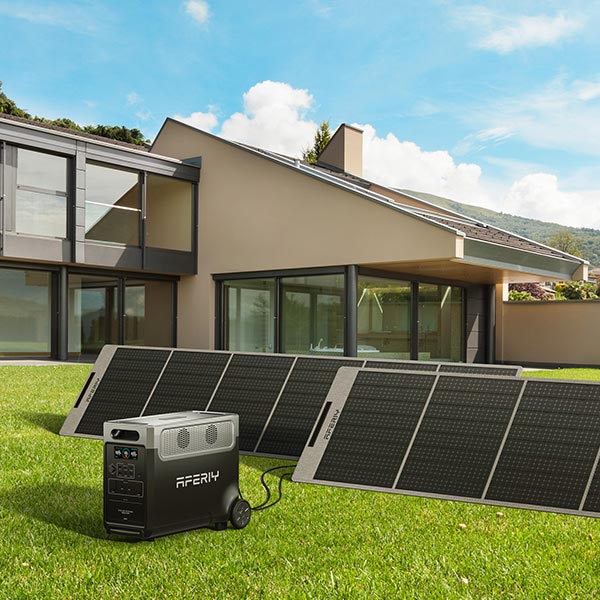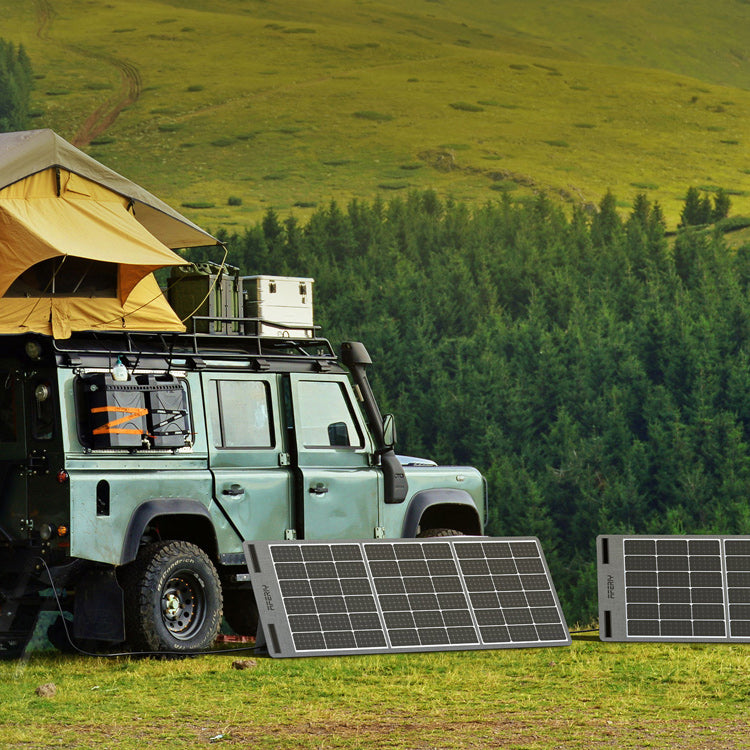Unlocking Solar Panel Secrets: Size, Weight, and Efficiency
Solar energy is at the forefront of the global shift towards sustainable and renewable power sources. Portable solar panels, the fundamental components of solar energy systems, play a pivotal role in harnessing the power of the sun. In this comprehensive guide, we will delve into the critical aspects of solar panel size and weight, shedding light on their significance and impact on solar energy systems. From understanding the dimensions of standard solar panels to exploring the factors that determine their size, we'll equip you with the knowledge needed to make informed decisions for your solar installation.

How Big Are Standard Solar Panels?
Dimensions of Typical Solar Panels:
Standard solar panels typically measure around 65 inches by 39 inches (approximately 5.4 feet by 3.25 feet).
Variations in panel size may occur, but this remains the most common dimension.
Evolution of Solar Panel Sizes Over the Years
The journey of solar panels has been a remarkable one, marked by continuous innovation and development in pursuit of efficiency and space-saving. As we delve into the evolution of solar panel sizes over the years, it becomes evident that these advancements have had a profound impact on the solar energy landscape.
Early Beginnings:
In the early days of solar technology, solar panels were bulky and far less efficient compared to today's standards. These early panels were primarily made of crystalline silicon, and their size was largely dictated by the need to capture as much sunlight as possible to generate a modest amount of electricity. As a result, they occupied a considerable amount of space on rooftops and solar farms.
The Emergence of Thin-Film Technology:
A significant milestone in the evolution of solar panel sizes was the development of thin-film technology. Thin-film solar panels, as the name suggests, are incredibly thin and flexible compared to traditional crystalline silicon panels. This breakthrough allowed for a dramatic reduction in size while maintaining reasonable efficiency levels.
Thin-film panels could be integrated into various surfaces, such as building materials and even clothing, paving the way for innovative applications in both urban and remote environments. The reduced size and weight of thin-film panels made them an attractive option for space-constrained installations.
Increased Efficiency and Energy Output:
Another key aspect of the evolution of solar panel sizes is the constant push for increased efficiency. Modern solar panels can convert a higher percentage of sunlight into electricity than their predecessors. This improved efficiency means that smaller panels can generate more power, making them even more space-efficient.
Advancements in solar cell technology, such as multi-junction and PERC (Passivated Emitter Rear Cell) cells, have contributed significantly to this increased efficiency. These developments allow solar panels to extract more energy from the same amount of sunlight, reducing the need for large, expansive installations.
Reduced Carbon Footprint:
The drive for smaller and more efficient solar panels extends beyond just saving space. It also aligns with the broader goal of reducing the carbon footprint of solar energy production. Smaller panels require fewer raw materials for manufacturing and less energy during production, transportation, and installation. This not only conserves resources but also reduces the overall environmental impact of solar panel manufacturing and deployment.
In conclusion, the evolution of solar panel sizes has been a remarkable journey characterized by increased efficiency and space-saving designs. From the bulky panels of the past to the sleek and powerful panels of today, solar technology continues to advance, making clean and renewable energy more accessible and practical for a wide range of applications. As we continue to innovate, we can expect even more exciting developments on the horizon, further propelling the growth of solar energy as a sustainable and efficient power source.

What Is the Average Area of a Single Solar Panel?
Calculation of Average Solar Panel Area
The average solar panel has an area of approximately 17.85 square feet (based on standard dimensions).
This area is crucial for estimating the number of panels needed for your energy needs.
Variations in Panel Area Based on Different Technologies
Advanced technologies, such as high-efficiency panels, may have smaller dimensions while delivering the same output.
Consider these variations when planning your solar installation.
Impact of Panel Area on Energy Output
Larger panels generally produce more energy, but they require more space.
Balance the trade-off between panel area and available installation space.

Factors Determining Solar Panel Size
Wattage and Power Output Requirements:
Determining your energy needs is the first crucial step in the process of selecting the appropriate solar panel size. This involves assessing how much electricity your household or business requires and then choosing panels with a wattage capacity that can meet these demands. It's important to note that higher-wattage panels, while generating more electricity, tend to be physically larger. This trade-off between size and power output is a key factor in optimizing your solar system.
Available Installation Space:
The available space for installing solar panels, whether it's on your rooftop or property, plays a pivotal role in determining the panel size. It's essential to conduct a thorough assessment to ensure that there is sufficient room for the desired number of panels. This step is critical in preventing issues related to overcrowding and maximizing the energy-generating potential of your installation.
Structural Considerations and Weight Limits:
Solar panels are not just about energy production; they also have a physical weight that must be supported by the underlying structure. Consulting with a structural engineer is a prudent move to ensure that your building or support structure can bear the weight of the solar panels. For larger installations, reinforcements may be necessary to guarantee the safety and integrity of the structure.
Efficiency and Cost-Effectiveness Trade-Offs:
Solar panels come in varying degrees of efficiency, which can influence their physical size. High-efficiency panels can generate more electricity with a smaller footprint but typically come at a higher initial cost. It's essential to carefully weigh the upfront expense of high-efficiency panels against the long-term energy savings they offer. Your choice should align with your budget and the long-term goals of your solar project.
Environmental Factors Like Wind and Snow Loads:
Local climate conditions are a significant consideration when selecting solar panel size. Factors like wind and snow loads can exert substantial forces on solar panels, potentially causing damage if panels are not designed to withstand these conditions. Ensuring that your chosen panels are rated to withstand the environmental challenges in your area is essential for the durability and longevity of your solar installation.
In summary, the selection of the right solar panel size involves a multifaceted decision-making process. Considering factors such as wattage, available space, structural integrity, efficiency, cost-effectiveness, and environmental conditions is essential in making an informed choice that maximizes energy production, ensures safety, and aligns with your specific project goals and constraints.

Common Sizes and Weights of Solar Panels
Residential Solar Panels
Residential panels typically range from 250 to 400 watts.
Common dimensions are 65 inches by 39 inches, with weights averaging around 40 to 50 pounds.
Commercial and Utility-Scale Solar Panels
Larger commercial and utility-scale panels can measure up to 8 feet by 4 feet.
Weights vary but often exceed 50 pounds.
Thin-Film and Flexible Solar Panel Variations
Thin-film and flexible panels offer versatility in terms of shape and installation.
They are lighter but may require more surface area.
Comparison of Weights for Different Panel Sizes
Weight increases with panel size.
Ensure your chosen structure can support the weight of the panels.

Importance of Choosing the Right Panel Size
Maximizing energy production:
The size of solar panels directly affects their energy production capacity. Opting for an appropriate panel size ensures the maximization of energy generation. Larger panels typically capture more sunlight, resulting in greater electricity production. This plays a pivotal role in the economic viability of a solar project, as energy output directly influences return on investment (ROI) and the long-term benefits of the project.
Ensuring efficient space utilization:
In solar energy projects, available space is often a limited resource. Selecting the right panel size guarantees optimal space utilization efficiency. Oversized panels may lead to wastage of valuable space, while undersized panels may fail to utilize the available area to its fullest potential. Therefore, precise panel size selection ensures the attainment of maximum energy output within the constraints of limited space.
Avoiding structural and safety issues:
Choosing the correct panel size also aids in preventing potential structural and safety issues. Solar panels need to be properly mounted on support structures. If the panel size does not match or is unsuitable, it can lead to structural damage or safety hazards. Properly matched panel sizes help ensure the structural integrity and safety of the project.
Meeting specific project requirements and constraints:
Every solar energy project may come with specific requirements and limitations, such as geographical location, available space, budget constraints, and regulatory requirements. Selecting the right panel size helps ensure that the project complies with these demands and restrictions. For instance, certain regions might impose maximum panel installation size limits, while budget constraints may necessitate a trade-off between panel size and quantity. Therefore, choosing the correct panel size is a critical factor in guaranteeing the success of the project.
In conclusion, choosing the right size for solar panels is essential for maximizing energy production, efficiently utilizing available space, avoiding structural and safety issues, and meeting specific project requirements and constraints. It is a key decision in ensuring the success of a solar energy project, requiring a comprehensive consideration of multiple factors to make informed choices.












Leave a comment
Please note, comments need to be approved before they are published.